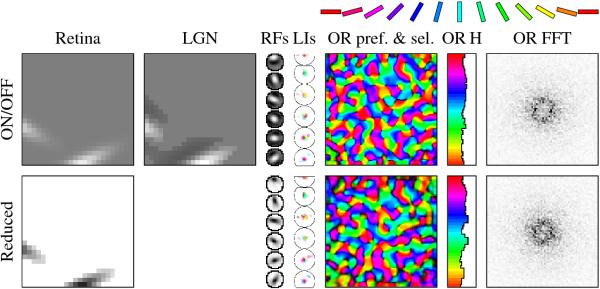
Click on the image to see a PDF version (for zooming in)
Fig. 6.4. Effect of ON/OFF channels on orientation maps. The
two rows show the results for two LISSOM networks trained with the
same stream of Gaussian inputs. The top network is the LISSOM OR map
from Section 5.3, and the bottom network is the reduced LISSOM model
of Figure 6.3. As in Figure 5.13, each row includes a sample retinal
activation, the LGN response (for the ON/OFF LISSOM network), the
final receptive fields of sample neurons, their inhibitory lateral
connections, the orientation preference and selectivity map, and the
histogram and the Fourier transform of the orientation
preferences. For the ON/OFF model, the inputs consisted of
photograph-like images of Gaussians such as those used in Chapters 4
and 5, shown in gray scale from black to white (low to high), with
medium gray representing background activation. In contrast, the
reduced LISSOM inputs were similar to the activations in the ON
channel, i.e. gray scale from white to black (low to high), with white
background. The reduced LISSOM RFs are shown in gray scale like ON
weights from white to black (low to high), whereas the ON/OFF LISSOM
RFs are combined by subtracting the OFF weights from the ON, as
e.g. in Figure 4.6. The RF orientations, lateral connections, and map
organization are almost identical in the two models. The RFs on the
ON/OFF channels have multiple ON and OFF lobes, and become slightly
more oriented. As a result, the ON/OFF map is somewhat more
selective. The histogram of each orientation map is nearly flat for
both networks, because the inputs were uniformly distributed. These
results show that as long as the maps are trained with the same stream
of Gaussian inputs, functionally similar maps develop with or without
the LGN. However, Figure 6.5 will show that the ON/OFF channels of the
LGN are necessary for processing natural images.
|